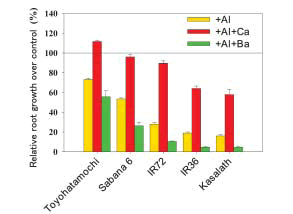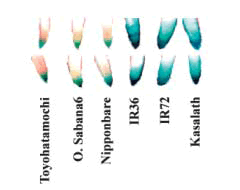Physiological mechanisms of aluminum resistance of rice varieties and the development of a rapid screening method for resistant genotypes
Description
[Objectives]
Upland rice is an important crop for small farmers in developing countries. The growth of upland rice is often reduced by the soil acidity of highly weathered soils (Oxisols and Ultisols) in tropical regions. Since many small farmers cannot use enough lime, the genotypes resistant to soil acidity should be developed. Fewer studies have been conducted for the acid-soil resistance of upland rice compared with the other crops such as wheat. A previous study by JIRCAS in South American savannas revealed that calcium (Ca) plays a major role in the genotypic differences in the resistance to soil acidity in Oxisols. In this study, the mechanisms of resistance to acid soils in rice was elucidated in relation to Ca in comparison to cases of wheat, and a new efficient screening method was proposed.
[Results]
The major inhibitory factor in acid soils is Al. The first symptom by Al is the inhibition of root elongation. Thus, the degree of Al resistance of rice was measured by the relative root growth in a culture solution containing Al. The degree of Al resistance was as follows: Toyohatamochi (73%) > Oryzica Sabana 6 (53%) > IR72 (28%) > IR36 (19%)  Kasalath (16%) (Fig. 1). Increasing Ca concentration in the solution recovered root growth in all genotypes, and the recovery rates were greater in susceptible genotypes (Fig. 1).
Kasalath (16%) (Fig. 1). Increasing Ca concentration in the solution recovered root growth in all genotypes, and the recovery rates were greater in susceptible genotypes (Fig. 1).
In the case of rice, the addition of barium (Ba), the congeneric element to Ca, to Al-affected roots further reduced root elongation (Fig. 1). However, in the case of wheat (Atlas cultivar 66), the addition of Ba recovered Al-affected roots (data not shown). These results suggest that the mechanisms of the resistance to Al differ between two crops.
For wheat, the hematoxylin staining which determines Al content in root tissue, has been used as a proven screening method for Al resistance. However, it is not possible to apply this methodology to rice, most likely due to the differing mechanisms of Al resistance in the two plant species as mentioned above. Keeping in mind that the relative adsorption of Al and Ca on root cell walls is directly related to the mechanisms of Al resistance in rice, a rapid screening method using pyrocatechol violet (PCV) was developed. In this method, the roots are first immersed in Al solution for 15 min, and then treated with Ca solution. The easily exchangeable Al is displaced by Ca in this process, allowing the detection of the hardly exchangeable Al at the root surface by PCV staining. Under this method, the root tips of susceptible varieties were more strongly stained than the three resistant varieties (Fig. 2). These results coincide with the results of root elongation (Fig. 1). When the Ca solution which displaces adsorbed Al was omitted from the process, differences in the degree of staining among the varieties became unclear (data not shown). In addition, the use of this method allows the rapid evaluation of Al resistance in rice varieties. Further tests should be carried out for the validation of this technique, through comparison of results with the growth rates of rice varieties planted in acid-soil fields.
Figure, table
-
Fig. 1.
Effects of the addition of Ca and Ba on the relative root growth of Al-affected rice roots.
[Control], 50μM Ca; [+Al], 50μM Ca + 20μM Al; [+Al+Ca], 500μM Ca + 20μM Al; [+Al+Ba], 50μM Ca + 450μM Ba + 20μM Al. -
Fig. 2.
Results of PVC staining of the roots of rice varieties after they were treated for 15 min with solutions containing 50μM Ca + 100μM Al, followed by a 45 min treatment with solutions containing 500μM Ca. Two replications of each variety is shown.
- Affiliation
-
Japan International Research Center for Agricultural Sciences Crop Production and Environment Division
- Classification
-
Technical A
- Term of research
-
FY2003 (FY2001-2003)
- Responsible researcher
-
OKADA Kensuke ( Crop Production and Environment Division )
WATANABE Toshihiro ( Crop Production and Environment Division )
- ほか
- Publication, etc.
-
Okada, K., Fischer, A.J., Perez-Salasar, F.A. and Canon-Romero, Y. (2003): Difference in the retention of Ca and Al as possible mechanisms of Al resistance in upland rice. Soil Sci. Plant Nutr., 49, 889–895.
Watanabe, T. and Okada, K. (2005): Interactive effects of Al, Ca and other cations on root elongation of rice cultivars under low pH. Ann. Bot., 95, 379–385.
- Japanese PDF
-
2003_14_A3_ja.pdf2.54 MB
- English PDF
-
2003_14_A4_en.pdf53.84 KB


